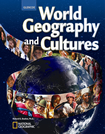 
World Geography and Cultures © 2012Chapter 9:
Cultural Geography of Latin AmericaWeb Activity Lesson Plans"The Panama Canal" Introduction
Students have read about the people and history of Latin America. The Panama Canal played an important role in the development of both Latin America and the United States as it facilitated trade and communication. A complicated relationship with far-reaching effects developed between Panama and the United States. The presence of the canal and the resulting development of the region has also affected the population and environment of Panama.
Lesson Description
Students will use information from CNN's in-depth special on the Panama Canal handover that took place on December 31, 1999. They will learn about the history of the canal and the role of the United States in Panama's history. They will answer four questions about the canal and the handover and will then write two diary entries about the handover. One entry will be from the point of view of a Panamanian student; the other will be from the point of view of a U.S. student whose parents have been working for the Canal Commission.
Instructional Objectives - Students will be able to narrate the history of the Panama Canal and the relationship between the United States and Panama.
- Students will be able to describe the effect the Panama Canal has had on the area's environment.
Applied Content Standards
Standard 13: The geographically informed person knows and understands how forces of cooperation and conflict among people influence the division and control of Earth's surface.
Standard 14: The geographically informed person knows and understands how human actions modify the physical environment.
Student Web Activity Answers - King Charles I of Spain ordered a survey for a possible canal in the 1530s. In the late 1800s, French entrepreneur Ferdinand de Lesseps tried to build a sea-level canal requiring a huge tunnel through the Continental Divide. Outbreaks of malaria and yellow fever caused at least 20,000 deaths.
- Assistant Secretary of the U.S. Navy, Theodore Roosevelt became the project’s main advocate. He saw the canal less as a tool for commerce, and more as a way to secure America’s position as a major world power. As president, Roosevelt pushed Congress to approve plans for a canal. He remembered the 1898 war with Spain and how the lack of a waterway connecting the two oceans slowed the arrival of the U.S. battleship as it traveled from San Francisco to the Caribbean.
- The United States used its power to back a Panamanian uprising and Panama's declaration of independence from Colombia in 1903. The United States then negotiated for a 10-mile-wide canal zone and the right to build a canal. In 1989 the United States invaded Panama and jailed Panamanian leader Manuel Noriega. The two countries have had a complicated relationship—Panama has depended on the United States's military power and economic support, but many Panamanians have resented U.S. dominance and control. The United States maintained virtually sovereign control over the Canal Zone until 1971 and over the canal until 1999.
- Stevens believed that building a canal at sea level was futile because it would be "constantly vulnerable to landslides." He thought that using Panama's wet climate and the powerful Chagres River would be the best chance for success. The river was dammed to create a reservoir to supply the canal with an unending supply of water. Situated below sea level, the canal would rely on gravity and power from hydroelectric dams on the Chagres River.
- Students' diary entries will vary.
 |  |
|

















